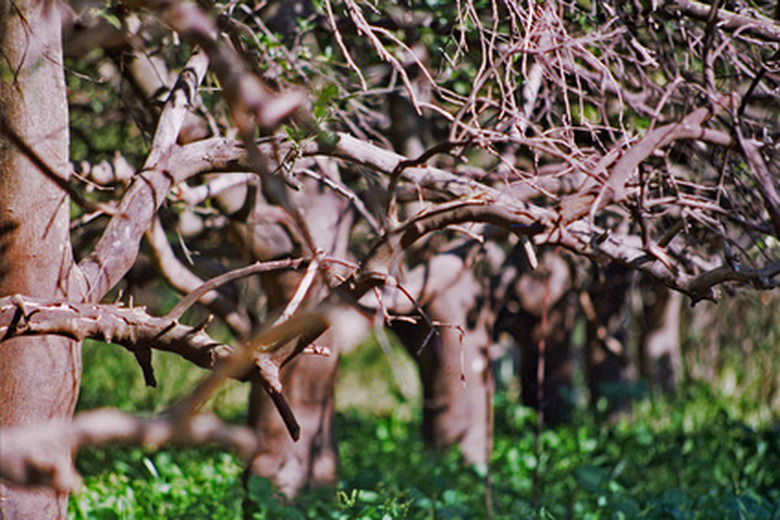Ground Cover Under Fruit Trees
The ground cover under fruit trees should provide an easy-to-maintain cover that requires little or no mowing. The companion plants can also benefit the fruit trees if they are species that contribute to the soil's nutrient makeup. When choosing ground-cover plants, the gardener should take into consideration the harvest needs of the fruit tree and the irrigation that the ground cover will receive to determine the ideal pairing.
Significance and Benefits
A ground cover works like a living mulch beneath the fruit tree and can significantly aid the tree. The use of legumes or perennial peanut crops benefits the fruit trees by fixing nitrogen back into the soil. They also require very little maintenance and help prevent soil erosion, according to the University of Hawaii. Grass valleys can help the soil in staying moist and preventing erosion. The use of legumes also helps minimize weeds from growing beneath the fruit trees and competing for needed nutrients. The use of grass provides a firm bed for heavy machinery needed to maintain the trees.
- The ground cover under fruit trees should provide an easy-to-maintain cover that requires little or no mowing.
- The companion plants can also benefit the fruit trees if they are species that contribute to the soil's nutrient makeup.
Adverse Effects
Growing grass beneath fruit trees has numerous effects on the fruit trees and the surrounding ground. The grass can compete with the trees for nutrients over time, which can eventually affect the trees' growth and may weaken the fruit production. The lack of nutrients may cause a small decline in a tree's overall health, according to the University of Wisconsin. Eventually the grass begins to grow right next to the tree's trunk and becomes difficult to mow. Legumes and peanut crops require more water to survive. The use of alfalfa is often difficult to control and eradicate once it is established in an orchard.
Considerations
Prior to planting fruit trees, the gardener should consider carefully which ground-cover plants to use. The ground cover should be planted at the same time as the fruit trees are planted. Establishing a good ground cover with young trees will help prevent weed growth. Many weeds, such as thistle, flourish on a spot that has been recently cleared to plant trees, so prompt planting of a ground cover will prevent the weeds from establishing themselves.
- Growing grass beneath fruit trees has numerous effects on the fruit trees and the surrounding ground.
- The use of alfalfa is often difficult to control and eradicate once it is established in an orchard.
Maintenance
Maintaining a ground-cover crop beneath fruit trees requires very little maintenance. Both the fruit trees and the plants that grown beneath them will require regular watering. Avoid overfertilizing the area. Use only enough fertilizer to benefit the fruit trees and try to overlook the needs of the ground cover to create the perfect balance. Mow grass beneath fruit fruit trees regularly to a height of 3 to 4 inches.
Weed Prevention
Even with a strong ground cover beneath fruit trees, the gardener will still be faced with the use of herbicides to help control and prevent weeds. Pre-emergence herbicides are often successful when used on ground cover beneath fruit trees to control weeds in the spring. A fall application of 2,4-D will help control dandelions.
- Maintaining a ground-cover crop beneath fruit trees requires very little maintenance.
